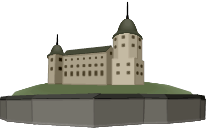52 Ancestors in 52 Weeks nos. 13 and 14—Alex and Ada Mattila

Suomi, or “Finland” as most people know it, is a Nordic country east of the Bothnian Sea. Three ancient tribes settled there, the Finns, the Tavastians, and the Karelians. Even after Finnish unification under the Swedes, the eastern area known as Karelia retained an identity of its own. The people had long traditions of folk music and mysticism, and today the Karelian culture is perceived as the purist expression of true Finnic ways and beliefs. The Finnish epic poem, The
Kalevala, draws mostly from Karelian folklore and mythology. Many of the works of the Finnish composer Jean Sibelius took influence from The Kalevala.
Ada and Alex Mattila came from Viipuri, Finland, at the southern end of Karelian lands. This historically Lutheran province of Finland, known for its iconic Vyborg Castle, now lies divided between Finland and Russia in the area between the Baltic Sea and the White Sea. Over the centuries, the Swedes and the Russians have exerted a heavy influence over Karelia.
Beginning in the 13th century, these two fought bitterly over it, and a treaty in 1323 divided Karelia between them. The city of Viipuri (“Viborg” to the Swedes and “Vyborg” to the Russians) became the capital of the new Swedish province and ultimately the second-largest city in Finland. The surrounding area became part of Viipuri parish.
The Swedes retained control of Finland, including their part of Karelia, for the next 500 years until the Napoleonic Wars. In the meantime, the Russians maintained the remainder of the ethnic Karelian lands. After Napoleon, the Russians received Finland from the Swedes as part of the war settlement, and a unified Finland became a Duchy of the Russian empire. Thus the Karelians were reunited for the next hundred years under one ruler, the Czar.
Early Life
Into this troubled land and time, Alexander Mattila was born. His parents were Elisabeth (“Liisa”) Myllynen and Antti Abelsson Mattila. The father was listed as “Anders” in the official Swedish-language records of the time. “Antti” and “Anders” are the Finnish and Swedish renderings of the English name, Andrew.
The Mattilas lived in the rural village of Alasommes/Alasommee, Viipuri province, Duchy of Finland, and Alex was probably born at home. The actual date remains in question with various records reporting April or May, on the 8th or ninth of the month as his birth date. Some documents give the year as 1878, others say 1879. The Viipuri rural parish record lists his birth date as May 9, 1878 with his baptism following three days later on the twelfth of May.
Alex was the youngest of at least nine children, and he was the only boy. The father died when Alex was quite small, and his mother made her living by laying out the dead. The boy Alex often accompanied her.
As a young man in 1904, Alex worked and resided at Kolikkoinmaki, Finland. He planned to marry Ada Alina Lampinen, and marriage banns were published in January 1904 at the Lutheran church in Viipuri.
Fair-haired Ada was the daughter of Matti Lampinen, a lodger, and Anna Miettinen. Ada was born on September 25, 1879 in the village of Nunnanlahdentie, Kuopio Province, Finland, north of Viipuri. The area now lies in the province of Eastern Finland, created in 1997. On November 16, 1879, Ada was baptized in the Juuka parish. Ada’s children later said they knew nothing of her family.
Ada and Alex were married in Viipuri on May 14, 1904, and Ada transferred her church membership to the Viipuri rural parish in July. By 1905 Alex was working as a laborer in Viipuri. Conditions in Finland were hard at that time. Harsh Czarist rule left the Finns with little power over their own affairs. There were periodic famines, and tuberculosis afflicted many people.
Perhaps some of these problems led Alex and Ada to devise a plan to immigrate to America. Alex applied for and received a Finnish passport in February 1905. Leaving Ada behind temporarily, he traveled to the port town of Hanko on the south coast of Finland to catch a boat to Liverpool, England.
There he boarded the Cunard steamship Ivernia on March 25, 1905 bound for the United States. He arrived in Boston, Massachusetts on April 9, 1905. He reported to the authorities that he planned to join his “uncle” (actually his brother-in-law) Oskar Silberg in Superior, Wisconsin. Many Finns settled in the Great Lakes area where the climate resembled that of Finland, and industries needed workers.
Ada followed later, probably after Alex had set up a home for them. She applied for a Finnish passport in June 1905 but no passenger record for her has been found. She had certainly arrived in the U.S. by November 27, 1906 when their first child, Martha Louise, was born in Hibbing, Minnesota.

Building a Family in Minnesota
For the next several years, Alex worked to establish himself in the multi-ethnic Hibbing area. At least until 1915, he labored among other Finns and other men from all over Eastern Europe in one of the numerous iron mines of northern Minnesota. Meanwhile, he and Ada struggled to learn English. The U.S. census reports that Alex could speak English by 1910 but Ada and little Martha could not. A new language was easier for men to learn because they went out to work every day and heard it spoken there. When reading the 1920 census, one can almost hear their heavy Finnish accents. Their household is listed under the name Alex Sandermattila.
On March 6, 1915 Alex filed a Declaration of Intent to become a citizen of the United States. He was described as five feet, five-and-a-half inches tall, weighing 160 pounds, with a light complexion, medium brown hair, and brown eyes. The same description appears on his World War I draft registration card dated September 10, 1918. He became a citizen of the United States in 1922.

During the World War I years, Alex and Ada added more children to their family. These came as a surprise to their daughter Martha, ending her 10 years as an only child. Her sister, Aida Sylvia, arrived on October 2, 1916.
Aida lived the longest of the Mattila children, passing away at age 83 on June 18, 2000 after suffering a broken hip. She married twice, first to Walter Jametsky. They held their wedding reception at the Mattila house, and Alex Mattila’s older sister Anna Mattila Anderson attended. She was a staunch member of the Finnish Temperance Society, and when she found out that Alex was serving liquor to the guests upstairs, she got mad and went home.
Aida and Walter had one daughter, Judith Ann, and soon divorced. After the divorce, Aida and Judy lived with the Mattilas while Aida worked as a hotel elevator operator. Aida later married John Kerzie on May 23, 1953. They lived in Chisholm, Minnesota in the house where John was born. John worked in the mines and was active in labor union affairs. Aida kept house, putting her college training in home economics to good use.
A brother for Martha and Aida entered the household on June 5, 1918 with the birth of Hugo Alexander Mattila. Hugo had a wild streak and got into a bit of trouble as he grew. Once he went on a “bum” to California, hitching a ride on a train with a pal. The friend fell off and was killed. Another time, Hugo joined the cavalry, did not like it, and needed his mother to pay for his release. Along the way, he also worked as a ski jump instructor and boxed in Golden Gloves. Contrary to the advice of his temperance-minded aunt Anna, he enjoyed visiting local taverns. When he had too much to drink there, his policeman brother-in-law Bjarne Bentsen would take him home in the police paddy wagon.
Hugo eventually joined the Army Air Corps. During World War II, he served as a bombardier in Europe and achieved the rank of Lieutenant. While in the service, he married Ann Dorchock. During their marriage, Hugo went to college on the GI Bill and earned a degree in Civil Engineering. Meanwhile, he and Ann had three children: Robert Ray, Beverly, and Karen Marie. Sadly, little Karen passed away at the age of 6 in 1952 due to spinal meningitis.
Sometime after that, Hugo and Ann divorced, and Hugo remarried right away. He and Donna lived in Gainsville, Florida and had 6 children together: Kathleen, Virgina, James, Karen, Kelly, and Brian.
Hugo suffered a stroke later in life and was confined to a wheelchair. He died from the effects of a fire in his home on December 5, 1987 at the age of 69.
The last child and second son of Ada and Alex Mattila, Peter Bernhard, was born on November 19, 1919. Pete was not yet a teenager when Martha’s children Joyce and Ron were born, and he played with them as he grew up. He took them skiing (on barrel staves) and golfing (with homemade clubs while he worked at the local golf course).

Pete and Hugo would get wind-up toys for Ron for Christmas and then invite him over to play with them before Christmas. Later, both of the Mattila sons joined the Civilian Conservation Corps (CCC) and lived in the camps.
Eventually, like his brother, Pete joined the Army Air Corps. He made it his career. His nephew Ron joined the Air Force, too, and during the Korean War they served near each other in Japan. According to Ron, Pete liked to get in bar fights when he was off duty. A few years later, on June 1, 1959, Pete died unexpectedly from a heart attack at age 39 while serving at Eglin Air Force base in Florida. The family later speculated that because Pete had never shown any signs of heart trouble, the Air Force was concealing his true cause of death.
 A Carpenter’s Life
A Carpenter’s Life
By 1920, with his family of two daughters and two sons complete after 15 years in America, Alex Mattila had found some financial success. He owned a home without a mortgage on 2nd Avenue in Hibbing. He and his family lived on the ground floor, and they rented upstairs rooms out to two other families.
Finland is known for its carpentry industry, and somewhere along the way Alex learned this craft. By 1920 he had left the mines and was working as a carpenter. He continued in this occupation for the rest of his life, working at various times for the Messba Construction Company and the Ryan and Stavn Lumber Company where he worked at the time of his death. Years after he died, people in Hibbing would remember him walking down the street, carrying his carpenter’s toolbox. He built houses, but in his spare time, he enjoyed fashioning little hand-carved toys for his children and grandchildren. He also built a lovely dollhouse for his granddaughter, Sharon Bentsen.
As their finances improved, the Mattilas moved to a home Alex built on Thirteenth Avenue in Hibbing. They also purchased some farmland near the Hibbing airport. They hoped it would be valuable someday. Until they felt ready to sell it, they used the land to grow vegetables and other food. Ada often took the children and grandchildren out there to pick berries and mushrooms.
Alex sent his daughters to college in the 1920’s and 1930’s although only Martha actually graduated. She earned a 2-year degree allowing her to teach elementary school, and she promptly left Minnesota for adventure in Montana.
There she taught at the Two Tree country school near Redstone and lived with the Ole Bentsens, a nearby farm family. Their younger children, Jennie and Otto, attended the school. Martha married their older son, Bjarne, at the end of the school year on June 2, 1928.
Martha and Bjarne stayed in Montana long enough for their eldest child, Joyce Beverly, to be born on April 8, 1929 in Plentywood. After that, they relocated to Minnesota where they lived next door to the Mattilas, in another house that Alex had built. Not long after the move, Martha and Bjarne had a son, Ronald Duane, on January 14, 1931. Bjarne worked as an electrician in the mines for a while and then joined the Hibbing police force.
The Mattila’s seemed to enjoy having grandchildren next door. Ada always had a cake ready for snacking while they relaxed in the covered porch. She regularly offered them her homemade bread, which she would let rise on the stovetop before baking it in the coal stove. Alex liked to tease her that the big stove served double duty as her dressmaker’s model.
Alex and Ada also spent time teaching the ways of the old country to the children. Joyce used to accompany her grandmother to the local Finnish sauna and her grandfather on trips downtown. Ron helped his grandfather make dandelion wine. Both kids were amazed that neither grandparent celebrated birthdays, nor did their grandfather attend church. They did their own doctoring, including lancing boils and pulling bad teeth with the pliers.
They continued to speak Finnish at home, and Martha spoke with Ada in that language when she did not want the children to eavesdrop. Later, when Aida and Judy lived in the Mattila house during the 1940’s, Judy learned very little English before she started school. The teacher had to contact Aida to request that she work on English skills with the little girl.
Ada and Martha did not get along particularly well, and others sometimes had to settle their differences. Since they lived next door to one another, they shared a clothesline in the back yard. Ada valued tidiness, and she always collected her clothespins from the line when she took in her laundry. Martha preferred convenience and left her clothespins on the line until next time. Unfortunately, by then Ada had usually collected all of Martha’s clothespins and taken them inside. The battle of the clothespins escalated until Bjarne finally stepped in. He painted all of Martha’s clothespins red so there would be no confusion as to their ownership.
Aside from these typical family squabbles, life went along more or less as usual through the World War II years. The family avidly read letters from Hugo and Pete in the war zone, and the parents must have worried about them. We can wonder how they felt when their Viipuri homeland was ceded to the Soviet Union in 1944. Most of the Finns living anywhere near Viipuri walked out of the area and resettled in other parts of Finland. Russians moved in to fill the void, and very few Finns live in Vyborg and its environs today.
A Sorrowful Ending
In early April, 1945, Alex returned home from a trip downtown and reported in his accented English, “Roosevelt, he die.” No one believed him. Yet, it was true. Four-term President Franklin Roosevelt had passed away just as Alex had heard in town.
A day or two later, on a Saturday evening, Ada handed Alex his usual silver quarter to spend during an evening out. He always walked into town to gather with friends at a local tavern on Saturday nights. Several hours later, the police came to the Mattila door.
The family learned that while Alex walked home along the railroad tracks that night, he had been struck and killed by a train. Someone needed to go down to identify the body. The task fell to his son-in-law, Martha’s husband Bjarne.
No one was more stunned than Ada. She said, “I no live long now.” Yet she did live another three years. After her husband’s death, she finally joined the local Lutheran church, something Alex had never wanted to do. She also remained active in the Finnish Temperance Society and the Order of Runeberg, a Finnish cultural group.
One spring day three years later, on May 12, 1948 she went down the street to fetch her young granddaughter, Judy, who was out playing. While they walked back home together, Ada collapsed and died of a cerebral hemorrhage at the age of 68. She was buried next to Alex in the Maple Hill Cemetery in Hibbing. Later, their son Peter was buried near them.
When she died, her estate was distributed according to a plan Alex had devised during the 1930’s. Aida received the house and its contents, Hugo received the money, and Peter received the farm. Martha, deemed “sufficiently provided for” by having already received an education and other forms of Alex’s goods , was disinherited.
, was disinherited.
That Alex and Ada had so much material wealth to leave behind is a tribute to their spirit. They had the courage and initiative to leave a bad situation to make a better life for themselves in a new land. They found a happy community of like-minded immigrants and thrived despite a language barrier, social stigma against immigrants, economic hardship during the Great Depression, and anxiety from two world wars. They gave their American-born children the tools they needed to succeed in life. They could be proud of what they had achieved.
Very interesting, my grandfather is Hugo Mattila. Please reach out to me.